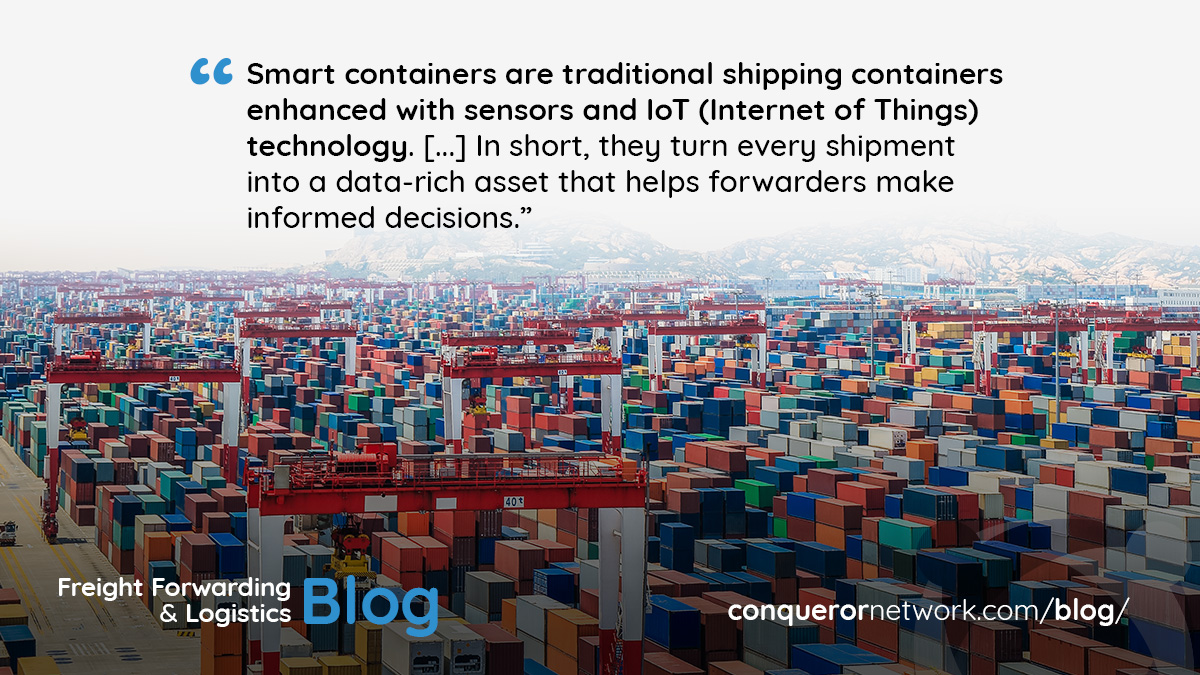Imagine a shipping container that tells you exactly where it’s, what condition it’s in, if it’s been tampered with, or if it’s deviating from its route, all in real-time. Welcome to the era of smart containers, where your cargo doesn’t just travel across oceans; it communicates. For independent freight forwarders and global freight networks, understanding and adopting smart container technology is no longer optional. It’s becoming a vital part of the digital freight forwarding revolution.
In this blog, we examine how the adoption of smart containers is shaping global logistics trends in 2025, identify the leading vendors, and outline what digital freight forwarders must do to remain competitive in a rapidly evolving landscape.
Smart containers: The backbone of digital freight forwarding
Smart containers are traditional shipping containers enhanced with sensors and IoT (Internet of Things) technology. These containers provide real-time cargo tracking, temperature monitoring, shock detection, geofencing, and security alerts. In short, they transform every shipment into a data-rich asset that enables forwarders to make informed decisions. This is where digital freight forwarding truly shines. By integrating smart container data into your freight management systems, you can offer clients unparalleled transparency, reduce risk, and respond proactively to issues before they become costly delays. According to industry research, smart container adoption is expected to grow by over 20% annually through 2030. The global logistics industry is undergoing a digital transformation, and smart container technology is at the heart of this change.

Global trends in smart container adoption
In 2025, the push toward greater cargo visibility and operational efficiency is stronger than ever. Here are some key global trends:
- Widespread Carrier Adoption: Major shipping carriers like Maersk, CMA CGM, Hapag-Lloyd, and MSC are investing heavily in smart container fleets to offer value-added services and streamline operations.
- Modal Shift & Multimodal Growth: As supply chains increasingly integrate multiple transport modes (ocean, air, rail, and road), smart containers are becoming essential for consistent tracking across the entire journey.
- Cold Chain and High-Value Goods: Industries like pharmaceuticals, electronics, and food rely on smart containers to monitor temperature and humidity, ensuring cargo arrives in perfect condition.
- Sustainability Goals: Smart container data helps optimize routes and reduce fuel consumption, supporting greener logistics operations.
- Middle-Mile Logistics: Smart containers are expanding into middle-mile logistics, bridging the gap between long-haul and last-mile delivery with real-time intelligence.
Top smart container vendors to watch
Several tech-forward companies are driving innovation in the smart container space. As a freight forwarder or member of a global freight forwarders’ network, it helps to know the key players:
- Traxens – Backed by CMA CGM and MSC, Traxens offers detailed sensor data and robust integration tools.
- SkyCell – Specializes in temperature-controlled containers for pharmaceuticals.
- Orbcomm – Provides global tracking and monitoring solutions for containers and intermodal assets.
- Nexxiot – Known for blockchain-ready smart sensors and predictive maintenance features.
- Loginno – Aims to turn entire container fleets into smart fleets, offering a SaaS model for tracking.
Working with vendors that support seamless integration into digital freight forwarding platforms is crucial for maximizing value.
Digital freight forwarding: Turning visibility into value
Digital freight forwarding isn’t just about automating quotes or digitizing paperwork; it’s about using smart technologies like smart containers to deliver better service and improve efficiency. Here’s how smart containers support the digital freight forwarding model:
- Proactive exception management: If a container is delayed or goes off route, alerts allow you to act fast, inform clients, and reroute if needed.
- Enhanced security: Sensors detect if a container is opened or tampered with, helping you mitigate theft or damage claims.
- Real-Time updates: Provide clients with live updates and ETA predictions, boosting trust and satisfaction.
- Customs and compliance: Real-time data can be used to streamline customs clearance and ensure compliance with temperature or security regulations.
Being part of a freight forwarders network that promotes digital tools makes adopting these solutions easier. It enables knowledge sharing, vendor referrals, and even co-investment in tech upgrades.
Challenges ahead: Regulation, integration, and cost
While the benefits are clear, smart container adoption isn’t without challenges:
- Regulatory uncertainty: Standards for data sharing, sensor calibration, and customs integration are still evolving.
- Integration costs: Smaller forwarders may find it expensive to implement smart container-compatible systems.
- Vendor fragmentation: With many players in the market, choosing a scalable and reliable vendor can be daunting.
Digital freight forwarding platforms that support API integration with smart container vendors can help overcome these hurdles. As adoption grows, costs are likely to decrease, and standards will become more consistent.
Looking ahead: Are you ready for smart container logistics?
The message for 2025 is clear: smart containers are no longer a luxury; they are a necessity for modern, digital freight forwarding. As global trade becomes more complex, clients will increasingly demand transparency, speed, and reliability, all areas where smart containers deliver.
To stay competitive:
- Evaluate smart container vendors that align with your operations
- Ensure your TMS or freight management software can handle real-time data
- Join or remain active in a freight forwarders network that supports digital tools
In the race toward smarter supply chains, those who adapt will lead. Those who wait may find themselves left behind.
Conclusion
Smart containers are changing the game for freight forwarders everywhere. They are at the intersection of data, logistics, and customer experience, and they perfectly complement the rise of digital freight forwarding. In 2025 and beyond, freight forwarders who embrace these tools and connect with like-minded partners through trusted logistics networks will be better positioned to thrive in an increasingly competitive and connected world.


